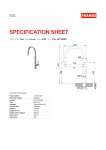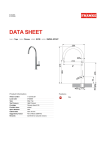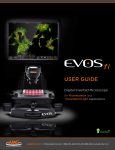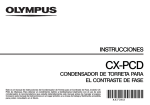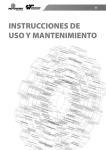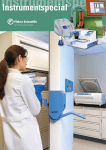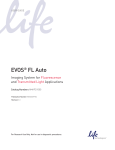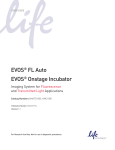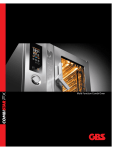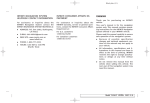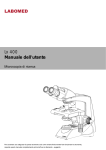Download AMG: EVOS User Manual - Thermo Fisher Scientific
Transcript
Digital Inverted Microscope User Guide 18421 Bothell-Everett Hwy. Suite 150 Mill Creek, WA 98012 Phone: Fax: E-mail: Web: (866) 614-4022 or (425) 368-0444 (425) 368-0555 [email protected] www.amgmicro.com The Microcsope Evolved. EVOS User Guide Co n t e n t s General Information....................................................................................................................................................... 2–3 Environmental Concerns..............................................................................................................................................................................2 Special Precautions........................................................................................................................................................................................2 Electrical Information....................................................................................................................................................................................2 Plain Stage Components.........................................................................................................................................................................3 Mechanical Stage Components.........................................................................................................................................................3 Specifications .............................................................................................................................................................................. 4 Assembly ....................................................................................................................................................................................... 5–6 Stage Plate Assembly....................................................................................................................................................................................5 Plain Stage....................................................................................................................................................................................................5 Mechanical Stage ......................................................................................................................................................................................5 Changing Stage Plates (Mechanical Stage)..........................................................................................................................5 Power Cord Assembly....................................................................................................................................................................................5 Objective Lens Assembly.............................................................................................................................................................................6 Filter Slider Assembly....................................................................................................................................................................................6 Operation ..................................................................................................................................................................................7–10 Dimmer (Illumination) Control..................................................................................................................................................................7 Illumination Pre-configured for Each Objective..............................................................................................................................7 Learning Function......................................................................................................................................................................................7 LCD Settings Control......................................................................................................................................................................................7 Objective Select Wheel.................................................................................................................................................................................8 Focus Control....................................................................................................................................................................................................8 Phase Annuli Select Wheel..........................................................................................................................................................................8 Mechanical Stage Operation......................................................................................................................................................................9 Secure Digital (SD™) Card............................................................................................................................................................................9 Image Capture Button................................................................................................................................................................................10 Micron(EVOS) via USB Connection........................................................................................................................................................11 Installing Micron(EVOS) Software.......................................................................................................................................................11 Installing Driver.........................................................................................................................................................................................11 Working With DNG Files in Micron(EVOS)...........................................................................................................................................12 LCD Positioning.............................................................................................................................................................................................12 Maintenance ........................................................................................................................................................................ 13–14 LCD Screen Care.............................................................................................................................................................................................13 Objective Lens Care.....................................................................................................................................................................................13 Stage Care........................................................................................................................................................................................................13 Firmware Update...........................................................................................................................................................................................14 Parts & Accessories . ............................................................................................................................................................. 15 Customer Service .................................................................................................................................................................... 16 © 2008 Advanced Microscopy Group, Inc. All rights reserved. GENERAL INFORMATION Environmental Concerns Figure 1 • (Figure 1) Place the microscope on a level surface away from vibrations of other pieces of equipment. To protect your microscope from environmental vibrations, we offer a tabletop Anti-Vibration Platform (part # AMEPVIP1) custom designed for EVOS. Note: Use the 4 adjustable rubber feet on the bottom of the base to adjust the microscope for uneven surfaces. • Ambient room lighting and sunlight from nearby windows can enter the imaging path and affect the image. Special Precautions Figure 2 When cleaning optical elements, use only materials that are specifically made for that purpose. Further, we recommend soft, low-lint, cloth materials. To avoid scratching the soft lens coatings, do not use paper-based materials. • Always carry the microscope with one hand supporting the base and the other hand on the neck , using correct lifting techniques. • Do not exchange objectives between microscopes unless you know that the components have all been approved and recommended by AMG. • If liquid spills on the microscope, turn off the power immediately and wipe dry. • Never disassemble or service the microscope yourself. Unauthorized repairs may damage the microscope or alter its functionality, and they will void your warranty. • After using, cover the microscope with a dust cover. Electrical Information Figure 3 (Figure 2) (Figure 3) • The power switch is located on the back of the microscope. • The detachable power cord output connection is located next to the power switch. 2 EVOS™ User Guide General Information PLAIN STAGE Secure Digital (SD™) Card Slot LCD Display LCD Tilt Knob USB Connect Port Note: Install software before connecting USB. Power ON Indicator LCD Settings Button LCD Control LED Lamp House LCD Positioning Knob Condenser Assembly Phase Annuli Select Wheel Image Capture Button Plain Stage Focus Control Power Cord Power Switch Objective Select Wheel Dimmer Adjustable Rubber Feet (4) MECHANICAL STAGE Secure Digital (SD™) Card Slot LCD Display LCD Tilt Knob USB Connect Port Note: Install software before connecting USB. Power ON Indicator LCD Settings Button LCD Control LED Lamp House LCD Positioning Knob Condenser Assembly Phase Annuli Select Wheel Image Capture Button Coarse Positioning Y-Axis Fine Positioning X-Axis Fine Positioning Focus Control Power Cord Power Switch Objective Select Wheel Dimmer Adjustable Rubber Feet (4) amgmicro.com 3 EVOS™ User Guide Specifications EVOS Specifications Optics Infinity corrected optical system Standard Objectives LWD; 4xBF, 10xPh, 20xPh; 40xPh (optional) Olympus Objectives LWD; 4xPh; 10xPh, 20xPh; 40xPh (optional) Objective Turret 4-position, with front-mounted control LCD Display 15”, color, 1024 x 768 pixels, controls for backlight contrast and saturation; adjustable positioning Camera 3MP color CMOS Captured Image Resolution 2048 x 1536 pixels Captured File Format DNG file format; 3MB/image Illumination LED, 50,000-hour service life with dimmer Contrast Methods Brightfield and Phase Contrast Standard Condenser 3-position turret for BF, 10x/20x Phase and 40x Phase Olympus Condenser Filter Assemblies 3-position turret for BF, 4x Phase and 10x/20x/40x Phase Brightfield: Pinhole and Diffuser filters included Phase: Green filter included Focusing Dual, low-position controls with rubber grip PLAIN Stage Working Distance with Condenser XX 196 mm x 196 mm (7.7” x 7.7”) plain stage; low-position, 110 mm (4.3”) from table; XX 62 mm (2.4”) XX Dimensions Height: 587 mm (23.1”) with LCD raised to maximum; Width: 363 mm (14.3”); Depth: 449 mm (17.7”) x-y axis fine-positioning controls; low-position, 110 mm (4.3”) from table XX interchangeable vessel holders available for most common shapes & sizes XX 110 mm x 110 mm (4.3” x 4.3”) viewable area Working Distance w/ Multi- XX 58.0 mm (2.3”) well Stage Plate Mechanical Stage XX XX Dimensions Height: 587 mm (23.1”) with LCD raised to maximum; Width: 363 mm (14.3”); Depth: 449 mm (17.7”) Weight 11.8 Kg (26 Lb.) - Plain Stage 13.6 Kg (30 Lb.) - Mechanical Stage Storage Device/Output Secure Digital (SD™) card or USB2 connection to PC Software Micron(EVOS) imaging software (included) Power Supply 4 AC Adapter; Input 100-240V, 50-60Hz, 0.5A; Output 12 VDC EVOS™ User Guide Assembly Figure 1 Stage Plate Assembly Plain Stage (Figure 1) The plain stage assembly is pre-installed and pre-positioned at AMG. Simply install the circular stage plate into the round opening in the stage.. Figure 2 Mechanical Stage (Figures 2 & 3) For AME i2111/2 and AME 3205/6 Series (Mechanical Stage) microscopes, follow the procedures below before use. 1. Screw in the 2 coarse positioning knobs into the front right and left-hand corners of the stage assembly. 2. Remove the stage lock pin on the back right-hand corner. Note: The stage lock pin is used to secure/hold the mechanical stage in place when transporting or moving the unit. Changing Stage Plates (Mechanical Stage) (Figure 3) 1. Unscrew the two 3 mm hex screws from the back of the stage with a hex tool (included). Figure 3 2. Unscrew the 2 coarse positioning knobs from the front of the stage. 3. Carefully lift the stage plate off from the stage assembly and replace. 4. Reattach all screws to secure. Power Cord Assembly Figure 4 (Figure 4) 1. Turn the power switch to the “” (OFF) position before connecting the power cord (transformer unit). 2. Insert the plug into the power outlet on the back of the microscope. 3. Insert the 3-prong plug from the power supply into a power socket. amgmicro.com 5 EVOS™ User Guide Assembly Objective Lens Assembly Figure 1 (Figure 1 - PLAIN STAGE) (Figure 2 - MECHANICAL Stage) The color-coded objectives match the color-coding label on the objective turret. When properly installed, EVOS will “know” which objective is in place and adjust the lighting and image capture parameters to suit. 1. Carefully remove the circular stage plate (PLAIN STAGE) or the vessel holder (MECHANICAL STAGE) from the stage assembly. 2. To prevent contamination to optical components, turn the objective select wheel left 1/2 click, to move the objective turret away from the optical path, before removing and installing the objective. 3. Install the objectives into the corresponding positions in the objective Figure 2 turret located inside the stage assembly (see labels). Note: Make sure the color coding on the objectives matches the color coding label on the turret so the automatic settings will work. 4. Turn the objective select wheel to switch between objectives. Please note that EVOS models AME-3201 and AME-3204 are configured for use specifically with the following objectives: 4x Phase Contrast, AMG part #AMEP-4602 (Olympus part #1U2C522P) 10x Phase Contrast, AMG part #AMEP-4603 (Olympus part #1U2C144P) 20x Phase Contrast, AMG part #AMEP-4604 (Olympus part #1U2C146P) 40x Phase Contrast, AMG part #AMEP-4605 (Olympus part #1U2C149P) Use with any other objectives besides those listed above will void AMG’s warranty support for your EVOS model AME 3201 or AME 3204 microscope. Filter Slider Assembly important! Use a filter assembly for brightfield. Figure 3 (Figure 3) Three filter slider assemblies are included with all EVOS microscopes. For brightfield applications you MUST use the Pinhole or Diffuser filter. Due to variances in sample size, color and thickness, actual filter use may differ from the standard filter use described below. • Pinhole filter slider assembly: brightfield, low magnification (4x/10x) • Diffuser filter slider assembly: brightfield, high magnification (10x/20x/40x) • Green filter slider assembly: may be used for phase-contrast at all magnifications (optional) Note: AMG strongly recommends NOT replacing or tampering with the lens element as it may cause damage to the filter assembly. 1. Insert the filter slider assembly into the filter slider slot on the condenser assembly. 2. Adjust focus, contrast, and/or illumination and view specimen on screen. 6 EVOS™ User Guide Operation Dimmer (Illumination) Control Figure 1 (Figure 1) 1. Turn the power switch to the “|” (ON) position. 2. Rotate the dimmer control located on the bottom right-hand side of the microscope base to adjust brightness/intensity. Illumination Pre-configured for Each Objective The illumination/brightness levels on EVOS microscopes are preconfigured for each individual objective for optimal performance. The microscope is set to recognize each objective automatically as the objective select wheel rotates. Learning Function EVOS microscopes are equipped with a memory function that remembers the last automatic or manual illumination setting that was used for each individual objective, even after being powered off. As the objectives are switched, illumination values return to the last set levels for each objective. LCD Settings Control Figure 2 (Figures 2 & 3) The LCD settings button gives the user direct control for the following LCD display settings: XX BACKLIGHT XX CONTRAST XX SATURATION 1. Press the LCD settings button to initiate settings control mode. 2. Turn the LCD control to adjust the setting (8 levels available) to desired view. Figure 3 3. When finished, wait approximately 4 seconds for the settings panel to close. amgmicro.com 7 EVOS™ User Guide Operation Objective Select Wheel Figure 1 (Figure 1) 1. Rotate the objective select wheel located at the bottom center of the microscope base until a desired objective is in position (see label). 2. The microscope will automatically recognize each individual objective and use the pre-configured illumination settings for optimal performance. 3. Rotate the phase annuli select wheel to the position that corresponds with the respective objective. Focus Control Figure 2 (Figure 2) 1. Focus control knobs are located on both sides of the microscope. Backward rotation will move the objective away from the specimen and forward rotation will move it toward the specimen. 2. Rotate as necessary to adjust focus of the specimen on screen. Note: Every EVOS microscope has a safety feature that incorporates a “slip-clutch” mechanism to protect the objectives. When the objective turret reaches the end of its travel range, the clutch makes a “clicking” sound as the focus control continues to turn. The objective does not move past the acceptable range. Phase Annuli Select Wheel Figure 3 (Figure 3) Phase rings are pre-installed and pre-aligned on the phase annuli select wheel for optimal performance. Realignment or re-centering is not required. For all service needs, refer to the Customer Service section. EVOS microscopes have 3 positions for phase contrast: STANDARD OPTICS OLYMPUS OPTICS XX brightfield (BF) brightfield (BF) XX 10/20x phase 4x phase XX 40x phase 10x/20x/40x phase Note: View through the small window in the front of the phase condenser assembly to set the phase annuli to its respective objective. The phase setting must correspond to the objective for proper operation. 8 EVOS™ User Guide Operation Mechanical Stage Operation Figure 1 (Figure 1) The free-motion “glide” stage operates and moves in all directions — horizontally, vertically and diagonally. 1. Maneuver the stage freely throughout its x-y range of motion using the 2 coarse-positioning knobs . 2. Turn either of the 2 y-axis fine-positioning controls toward the front to move the stage forward and toward the back to move the stage backward. 3. Turn the x-axis fine-positioning control counter-clockwise to move the stage to the left and clockwise to move the stage to the right. Secure Digital (SD™) Card Figure 2 (Figures 2 & 3) The SD memory card slot is located on the top of the LCD display. Note: Before using the SD card, format the disk/card by following the manufacturer’s format disk procedures. 1. Gently pull out the protective rubber cover from the LCD frame. 2. Insert the SD card with the angled corner facing bottom left-hand side (see Figure 3) into the slot until it clicks and the card locks into position. Figure 3 Card 3. Remove the card by pressing it down to release it from the slot. Note: Do not remove SD card until “STORING: EVOS____.DNG” clears from the LCD screen amgmicro.com 9 EVOS™ User Guide Operation Image Capture Button Figure 1 (Figure 1) The image capture button is located on the right-hand side of the microscope, directly behind the right focus control. To save an image on an SD™ card: 1. To capture/save an image on an SD card, insert the card into the card slot located on top of the LCD display as described on page 9. 2. Focus the image on screen to desired view. 3. Press the image capture button located behind the right focus control. 4. A “STORING:EVOS0000.DNG” display will flash on the LCD screen beneath the SD card slot for about 3 seconds to indicate that EVOS is saving the image onto the memory card. To save an image on a PC via Micron(EVOS): 1. To capture/save an image on a PC via Micron(EVOS), remove the SD™ card from the card slot (SD card is set as default for saving images). 2. Connect the USB cable after the software has been installed as described on page 11. 3. Launch Micron(EVOS). 4. Focus the image on screen to desired view. 5. Press the image capture button located above the right focus control. 6. Choose file name and file location when prompted. Note: Images are saved as Digital Negative (DNG) files that can be opened with Micron(EVOS) or other Adobe® imaging applications. Files are 2048 x 1536 pixels in dimension and approximately 3MB in size. 10 EVOS™ User Guide Operation Figure 1 Micron(EVOS) via USB Connection (Figure 1) The USB connection port allows images to be viewed, captured, saved, edited, and analyzed directly on a PC via a USB2 cable (included) with AMG’s Micron(EVOS) imaging software (included) IMPORTANT! Install the software before attaching the microscope to PC. System Requirements (Minimum) XX PC with Pentium® IV 1.8 Ghz CPU or higher XX Windows® XP Operating System XX 30 MB of hard drive space for application software XX One open USB 2.0 port (Intel® chipset preferred) XX 256 MB RAM Installing Micron(EVOS) Software 1. Insert Micron(EVOS) software CD into CD drive 2. At the Welcome dialog, click Next to continue. 3. At the License Agreement dialog, select “I accept the agreement” to continue. 4. At the Select Destination Location dialog, click Next to accept the default application location to continue. 5. At the Select Additional Tasks menu, choose desired placement of available icons and click Next to continue. 6. At the Ready to Install dialog, review and verify install settings and click Install to continue. 7. At the Information screen, click Next to continue. 8. At the Completion screen, click Finish to finalize software installation. Installing Driver 1. After installing Micron(EVOS), connect the microscope to a PC using the USB2 cable (included). 2. When prompted, browse to the Micron CD and select the installation disk folder: CD Drive:\Westover USB2 EVOS Installation Disk. amgmicro.com 11 EVOS™ User Guide Operation Working with DNG Files in Micron(EVOS) Figure 1 DNG (Digital Negative) files saved on the SD™ card using EVOS can be opened in Micron(EVOS) or other Adobe imaging applications (for installation procedures, see Installing Micron(EVOS) Software on page 11). To open DNG files saved in EVOS: (Figure 1) 1. Insert the SD card with the saved image(s) into the card reader on your PC. 2. Open/launch Micron(EVOS). 3. Select File > Open from the menu toolbar (see Figure 1). 4. Select Other Image Files from Files of type: drop-down list. 5. Once the image is opened, select File > Save As... and choose a format option to save the image: • .png (Portable Network Graphic) • .jpg (JPEG) • .bmp (Bitmap) Note: For detailed operation procedures, go to the Micron(EVOS) User Guide (PDF) on the Micron(EVOS) Installation CD or select Help > User Guide... in the Micron(EVOS) Main menu toolbar to access the guide. Figure 2 LCD Positioning (Figure 2) There are 2 LCD positioning knobs located on either side of the microscope that control the vertical placement of the LCD screen and 1 LCD tilt knob that controls the angle of the LCD screen. Loosen and tighten as necessary to get the desired position for optimal view. 12 EVOS™ User Guide Maintenance LCD Display/Screen Care To clean the LCD screen: 1. Turn the power OFF. 2. Use a soft, dry, lint-free cloth to wipe off any dust from the screen. 3. For blemished areas, use a cleaner that is intended for LCD (liquid crystal display) screens only. Do not spray directly onto the screen, as it may drip into the display. Dampen a clean cloth to wipe the screen. Objective Lens Care Clean each objective periodically or when necessary with a clean lint-free cloth and lens cleaning solution. To avoid scratching the soft lens coatings, do not use paper-based materials. Note: To protect all optical components of the microscope, use the dust cover (included) when the microscope is not in use. Stage Care XX XX Clean the stage regularly to keep it dry and clear of debris. When moving Mechanical Stage microscopes, be sure to lock the stage with the stage lock pin to prevent the stage from sliding around. Note: To protect all optical components of the microscope, use the dust cover (included) when the microscope is not in use. amgmicro.com 13 EVOS™ User Guide Maintenance Firmware Update Figure 1 To update firmware: 1. Download the latest EVOS firmware onto an SD™ card from the AMG web site. 2. Turn power OFF. 3. Insert the SD card into the card slot. 4. Press and hold the Firmware Update Button (LEFT) while turning the power ON (see Figure 1). 5. When the microscope powers on, release the Firmware Update Button. You will see the firmware version that is on the SD card in the 4th line of the 2nd paragraph (see Figure 2). Figure 2 EVOS Firmware Updater Version 1.01 EVOS Model: AME-I Hardware Rev: 1.00 Firmware Rev: 1.01 Waiting for SD Card Insertion Found Card -> Loading firmware Loaded firmware.bin file Firmware Rev on SD Card: 1.01 Push Right Button to Start Update Firmware Rev on SD Card: X.XX Note: If the existing firmware version is the same as the version on the SD™ card, it is not necessary to update the firmware. 6. Push the Image Capture Button (RIGHT) (see Figure 1) to start the update. 7. The screen will display the update progress (see Figure 3). Note: DO NOT POWER OFF while the firmware is being updated. The update will take approximately 3 minutes to complete. Figure 3 Push Right Button to Start Update Updating Unit -> DO NOT POWER OFF <Chip Erase Starting Chip Erase Complete - verifying Erase verified FPGA Configuration Data being written to flash Updater Firmware being written to flash Diag Routine being written to flash Fonts Bitmap being written to flash Application Firmware being written to flash Verifying Firmware Firmware Verified To verify firmware version: 1. Turn power OFF. 2. Press and hold the Firmware Update Button (LEFT) while turning the power ON (see Figure 1). 3. When the microscope powers on, release the Firmware Update Button. The screen will display the EVOS model number, hardware version, and firmware version (see Figure 2). Reset Power to complete firmware upgrade 14 EVOS™ User Guide Parts & Accessories Vessel Holders EVOS Microscopes with Olympus Optics Item Part Number Item Part Number PLAIN Stage: no objectives included AME-3201 Plain Stage: 4xPh, 10xPh, 20xPh AME-3202 Vessel Holder for Slides; holds two 12mm x 75mm standard microscope slides, chamber slides, etc. AMEP-VH001 Plain Stage: 4x, 10xPh, 20xPh, 40xPh AME-3203 Mechanical Stage: no objectives included AME-3204 Vessel Holder for Petri Dishes; holds four 35mm dishes AMEP-VH002 Mechanical Stage: 4xPh, 10xPh, 20xPh AME-3205 Vessel Holder for Petri Dishes; holds two 60mm dishes AMEP-VH003 Vessel Holder for Petri Dish; holds one 100mm dish AMEP-VH004 Vessel Holder for T-flasks; holds two 25cm2 flasks, rectangular or triangular AMEP-VH005 Vessel Holder for Nunc T-75 Flask; holds one 75cm2 flask AMEP-VH006 Vessel Holder for Hemacytometer; holds one 76mm x 33mm standard hemacytometer AMEP-VH007 Vessel Holder for BD/Greiner T-75 flask; holds one 75cm2 flask AMEP-VH008 Vessel holder for all vessel types; plain stage functionality AMEP-VH009 Vessel Holder for BD/Greiner T-25 flask; holds one 25cm2 flask AMEP-VH010 Mechanical Stage: 4x, 10xPh, 20xPh, 40xPh AME-3206 NOTE: EVOS microscopes with Olympus Optics are configured for use specifically with the Olympus objectives listed below. Use with any other objective besides those Olympus objectives listed below will void AMG’s warranty support for your EVOS microscope. with Olympus Optics. Objectives, Olympus Item AMG Part No. Olympus Part No. 4x Phase Objective AMEP-4602 1-U2C522P 10x Phase Objective AMEP-4603 1-U2C144P 20x Phase Objective AMEP-4604 1-U2C146P 40x Phase Objective AMEP-4605 1-U2C149P EVOS Microscopes with Standard Optics Item Part Number Mechanical Stage: 4x, 10xPh, 20xPh AME-i2111 Accessories Mechanical Stage: 4x, 10xPh, 20xPh, 40xPh AME-i2112 Plain Stage: 4x, 10xPh, 20xPh AME-i2101 Plain Stage: 4x, 10xPh, 20xPh, 40xPh AME-i2102 NOTE: Objectives are not interchangeable between EVOS systems with differing optics packages. Objectives, Standard Item Part Number Power Adapter ZP-EC-00436 Dust Cover ZP-PKG-0403 Circular Metal Stage Plate (Plain Stage) AMPI-MSP1 USB2 Cable ZP-EC-00365 Anti-Vibration Platform AMEP-VIP1 Filter Slider Assemblies Item Part Number 4x Objective AMPI-OP004 Item Part Number 10xPh Objective AMPI-OP010PC Filter Slider Assembly – Green AMEP-CFG 20xPh Objective AMPI-OP020PC Filter Slider Assembly – Pinhole AMEP-AS15 40xPh Objective AMPI-OP040PC Filter Slider Assembly - Diffuser AMEP-DFS1 amgmicro.com 15 EVOS™ User Guide Customer Service Warranty Information Statement of Limited Product Warranty EVOS™ microscopes are warranted to be free of all defects in material and workmanship for a period of 60 months (5 years) from the date of delivery. The warranty does not apply to any instrument which has become worn, defective, damaged, or broken due to normal wear, Contact Information abuse, misuse, tampering, or unauthorized repairs. Under this warranty, Advanced Microscopy Group will repair or replace, without charge to the TOLL FREE (US & Canada) Customer & Technical Service purchaser, any part which, upon our examination, appears to be defective in materials or workmanship. 866-614-4022 Local & International Returned Goods Policy for Repair or Replacement Parts Customer & Technical Service 425-368-0444 To return goods for repair or replacement, please contact Advanced Fax 425-368-0555 Microscopy Group Customer Service by one of the numbers at the E-mail [email protected] Web site www.amgmicro.com left. Please be prepared to supply the following information: -- Your name, return shipping address and telephone number ---- Advanced Microscopy Group customer service business hours are 8:00 a.m. – 4:00 p.m. Pacific Standard Time. After hours, you may leave a telephone message. We will return your call the following business day. Catalog/Model number of the item(s) you are returning Serial Number(s), if applicable Description of the product’s problem or reason for the return Disclaimer Information provided by Advanced Microscopy Group, Inc. is believed to be accurate -- Date the item was purchased -- Distributor information, if applicable A Westover Representative will issue you a Return Materials and reliable. However, no responsibility is assumed by Advanced Microscopy Group Authorization (RMA) number. Please label the outside of your for its use. The information contained in this publication is subject to change without shipping container with this number. For any additional information, notice. Words that Advanced Microscopy Group considers trademarks have been please call Customer Support: 1-866-614-4022 or 1-425-368-0444. identified as such. However, neither the presence nor absence of such identification affects the legal status of any trademark. Units of measurement in this document conform to SI standards and practices. All rights reserved. No part of this publication may be reproduced, stored in a retrieval system, or transmitted in any form, be it ADVANCED MICROSCOPY GROUP, INC. electronically, mechanically, or by any other means such as photocopying, recording, 18421 Bothell-Everett Hwy or otherwise, without the prior written permission of Advanced Microscopy Group. Suite 150 Thanks for being our valued customer! Advanced Microscopy Group, Inc. is a Mill Creek, WA 98012 Seattle-area (Mill Creek, WA) optical equipment design and manufacturing firm with a domestic and international client base. Advanced Microscopy Group designs, develops, and manufactures optical systems and software for scientific, biotechnology, industrial, and educational fields. amgmicro.com 16 EVOS™ User Guide Doc Control Number ZP-PKG-0397 REV D2 © 2008 Advanced Microscopy Group, Inc. All rights reserved.


















